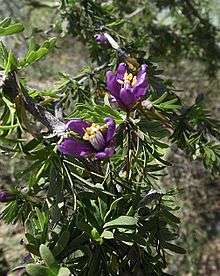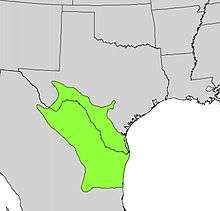Guaiacum angustifolium
Guaiacum angustifolium is a species of flowering plant in the caltrop family, Zygophyllaceae. Common names include Texas guaiacum, Texas lignum-vitae, soapbush and huayacán. It is native to southern and western Texas[3] in the United States and northern Mexico.[2] The specific name is derived from the Latin angustus, meaning "narrow," and -folius, meaning "-leaved".[4]
| Guaiacum angustifolium | |
|---|---|
 | |
| Scientific classification | |
| Kingdom: | Plantae |
| Clade: | Tracheophytes |
| Clade: | Angiosperms |
| Clade: | Eudicots |
| Clade: | Rosids |
| Order: | Zygophyllales |
| Family: | Zygophyllaceae |
| Genus: | Guaiacum |
| Species: | G. angustifolium |
| Binomial name | |
| Guaiacum angustifolium | |
 | |
| Natural range | |
| Synonyms | |
Location
This tree can be found in the area around the Rio Grande river including Austin, Matagorda Bay, New Braunfels, San Antonio, Brownsville and Fort McIntosh westward to the Rio Pecos. In the 19th century trees growing along the outskirts of this region were so small they were described by the United States Department of Interior as "low shrub(s)". The largest examples could be found on the hillsides near the Guadalupe river valley.[5]
Description
Texas lignum-vitae is a many branched shrub or small tree, reaching a height of 7 m (23 ft).[6] This evergreen has a dense canopy and short lateral branches.[7]
Leaves
Leaves are 1–3 cm (0.39–1.18 in) long, opposite and pinnately compound, with four to eight pairs of leaflets. The dark green, leathery, linear to linear-spatulate leaflets are 5–16 mm (0.20–0.63 in) long and 2–3 mm (0.079–0.118 in) wide. Leaflets fold themselves at night and when exposed to hot sunlight.
Uses
Like other species in its genus, the wood of G. angustifolium has extreme hardness and density and will sink in water. The sapwood is creamy yellow, while the heartwood is dark purple-brown.[11] The wood is used for fence posts, tool handles, and firewood. Root extracts are used to treat rheumatism and sexually transmitted diseases.[7] Soap can be made from the root bark, as it contains saponin; historically soap made in this way would be used to wash wool, since it does not fade the dyed-colors.[12][13] The bark of the roots is also used as a disinfectant.[13] The flowers are valued by beekeepers for their consistent nectar production.[14] Texas lignum-vitae is cultivated as an ornamental because of its drought tolerance, dense foliage, compact size, gnarled branches, and fragrant flowers.[9] It is used in hedges, rock gardens, and xeriscaping.[7]
Ecology
Guaiacum angustifolium is a host plant for the caterpillars of the lyside sulphur (Kricogonia lyside).[15] The leaves contain 16-18% crude protein and are browsed by White-tailed deer.[16]
Conservation
Like other members of its genus, the international trade of Texas lignum-vitae is restricted by CITES Appendix II. Only seeds, pollen, and finished products ready for retail sale may be legally exported.[17]
References
| Wikimedia Commons has media related to Guaiacum angustifolium. |
| Wikispecies has information related to Guaiacum angustifolium |
- "Guajacum angustifolium - Engelm. Texas Guaiacum". NatureServe Explorer. NatureServe. Retrieved 2009-11-28.
- "Guaiacum angustifolium". Germplasm Resources Information Network (GRIN). Agricultural Research Service (ARS), United States Department of Agriculture (USDA). Retrieved 2009-11-28.
- "Guayacan, Guajacum, Soapbush, Texas Porlieria". Texas Native Plants Database. Texas A&M University. Retrieved 2009-01-29.
- Eggli, Urs; Leonard E. Newton (2004). Etymological Dictionary of Succulent Plant Names. Birkhäuser. p. 11. ISBN 978-3-540-00489-9.
- Sargent, Charles S. (1884). Report on the Forests of North America. United States Department of the Interior. p. 29.
- Richardson, Alfred (1995). Plants of the Rio Grande Delta. University of Texas Press. p. 123. ISBN 978-0-292-77070-6.
- "Guayacan Soap-bush Guaiacum angustifolium Engelm". Native Plants of South Texas. Texas AgriLife Research and Extension at Uvalde. Archived from the original on 2010-07-14. Retrieved 2009-12-07.
- Powell, A. Michael (1998). Trees and Shrubs of the Trans-Pecos and Adjacent Areas. University of Texas Press. pp. 203–204. ISBN 978-0-292-75147-7.
- Mielke, Judy (1993). Native Plants for Southwestern Landscapes. University of Texas Press. p. 158. ISBN 978-0-292-75147-7.
- "soapbush Zygophyllaceae Guaiacum angustifolium Engelm". VTreeID. Virginia Polytechnic Institute and State University. Archived from the original on 2010-08-08. Retrieved 2010-10-04.
- "Guayacán Guaiacum angustifolium Engelm". Ethnobotany of the Lower Pecos Canyonlands. Texas Beyond History. Retrieved 2009-12-07.
- Irish, Mary (2008). Trees and Shrubs for the Southwest: Woody Plants for Arid Gardens. Timber Press. pp. 205–206. ISBN 978-0-88192-905-8.
- Standley, Paul C.; Blake, S. F. (1923). "Trees and Shrubs of Mexico (Oxalidaceae-Turneraceae)". Contributions from the United States National Herbarium. Washington, D.C.: Department of Botany, Smithsonian Institution. 23 (3): 522. JSTOR 23492504.
- Pellett, Frank Chapman (1920). American Honey Plants. American Bee Journal. p. 237.
- "Lyside Sulphur Kricogonia lyside (Godart, 1819)". Butterflies and Moths of North America. Archived from the original on 2010-06-20. Retrieved 2009-11-28.
- "Guayacan (Guajacum angustifolium)". Native Plant List. Caesar Kleberg Wildlife Research Institute. Archived from the original on 2011-07-20. Retrieved 2010-08-20.
- "Guaiacum angustifolia Engelm". UNEP-WCMC Species Database: CITES-Listed Species. CITES. Retrieved 2010-10-04.
External links
- "Guaiacum angustifolium" (PDF). Digital Representations of Tree Species Range Maps from "Atlas of United States Trees" by Elbert L. Little, Jr. (and other publications). United States Geological Survey.
- "Guajacum angustifolium Engelm. Texas lignum-vitae, Guayacan, Soapbush". Native Plant Information Network. Lady Bird Johnson Wildflower Center.
